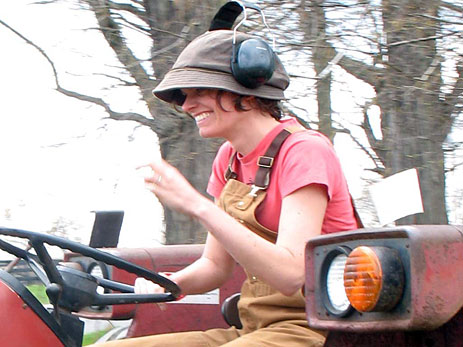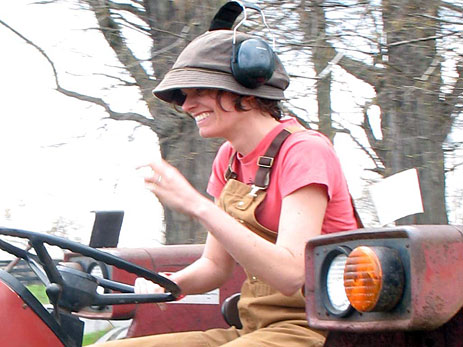 Lindsey Shute and her husband run Pistil Farm and Hearty Roots Community Farm in Tivoli, New York.
Lindsey Shute and her husband run Pistil Farm and Hearty Roots Community Farm in Tivoli, New York.
Back in the heady days of our youth when anything seemed possible — you know, 2009 — USDA Chief Tom Vilsack called for 100,000 new farmers. He even followed it up the next year with $17 million dollars in grants for the Beginning Farmers and Ranchers Training Program designed to help educate and mentor young farmers and ranchers.
Farmers, after all, are an aging bunch. According to the 2007 USDA Agricultural Census, the median age of farmers in the U.S. is 57 years old and rising. Sixty may be the new 50, but even so, America needs the next generation of farmers to step up.
It’s not surprising that farming hasn’t been a very attractive field for newcomers. New farmers face high land and fuel costs, corporate consolidation, price volatility, and cost-cutting retailers. They’re often asked to work long hours, use heavy equipment, and handle dangerous chemicals — all for a low-margin business. And the spike in commodities like corn, wheat, and soy, while a boon to some current farmers, is raising the bar ever higher for beginners.
If we learned anything from the housing bubble, it’s that there’s nothing Wall Street loves more than real estate. Land around cities is seen as too valuable to farm. And, as Tom Philpott dug up in his post on commodities speculation, analysts on Wall Street are specifically hyping farmland as an “investment vehicle” to their clients. If enough investors take their advisers up on the suggestion, however, this vehicle may force potential young farmers right off the road.
Of course, an excellent recent report from WBUR details that the problem goes beyond just the upfront costs of land and equipment. Banks don’t have much interest in investing in first-time conventional commodity farmers. The article profiles Austin Bruns, a young farmer who grows soybeans and corn under contract for Monsanto on 150 acres of Nebraska company land, sharing equipment to make ends meet. An economist quoted in the piece addresses the real estate conundrum:
[Some people are] sitting in New York [and] saying, ‘Well, I don’t know, I’ve never even been to Nebraska, but by golly, I’m going to buy some Nebraska land,’ And you have these groups coming together … that are buying farmland [and] driving up farmland prices to prices we’ve not seen before.
Banks have been through too many farm crises to want to bet on a new crop of commodities farmers. That said, the USDA is doing what it can to help. Earlier today, Deputy Secretary of Agriculture Kathleen Merrigan announced $18 million in new grants for beginning farmers. In a press conference, she said she just returned from a farm tour where she “got an earful … about land prices.” The good news was that a significant amount was dedicated to sustainable practices training or granted to sustainable organizations across the country. She did, however, admit the USDA currently lacks sufficient “tools in the toolbox” — read: funding — to address rising land prices; she hopes it’s something the upcoming Farm Bill negotiations will include.
Looking at the grants, it does seem like much of the excitement among beginning farmers seems to reside in organic fruit and vegetable production rather than in adding to the river of corn and soy that flows from the Midwest. In fact, it’s possible that more conventional commodity farmers will make the switch to organics.
One inspiring model appeared in The New York Times Magazine last year. The article profiled two old hands — husband and wife farmers Kurt and Karen Unkel of Kinder, La. After many years of struggling with all these issues, the pair abandoned conventional rice farming (including selling into commodities export markets) in favor of organic rice grown for local markets. “I started this because I could not see the future in conventional farming,” Kurt Unkel told the magazine. And their risk paid off. But the article left me wondering: Are transitions like this something the USDA will ever fully embrace?
With Wall Street and international investors bidding up the price of the land itself, it’s not hard to imagine a future where most farmers aren’t owner-operators but are hired hands on massive corporate farms. To avoid such a fate, we’ll need more than just training programs and enthusiasm: It requires a willingness by the federal government to take on Wall Street and anti-competitive corporations. And so far, I’m not impressed.



